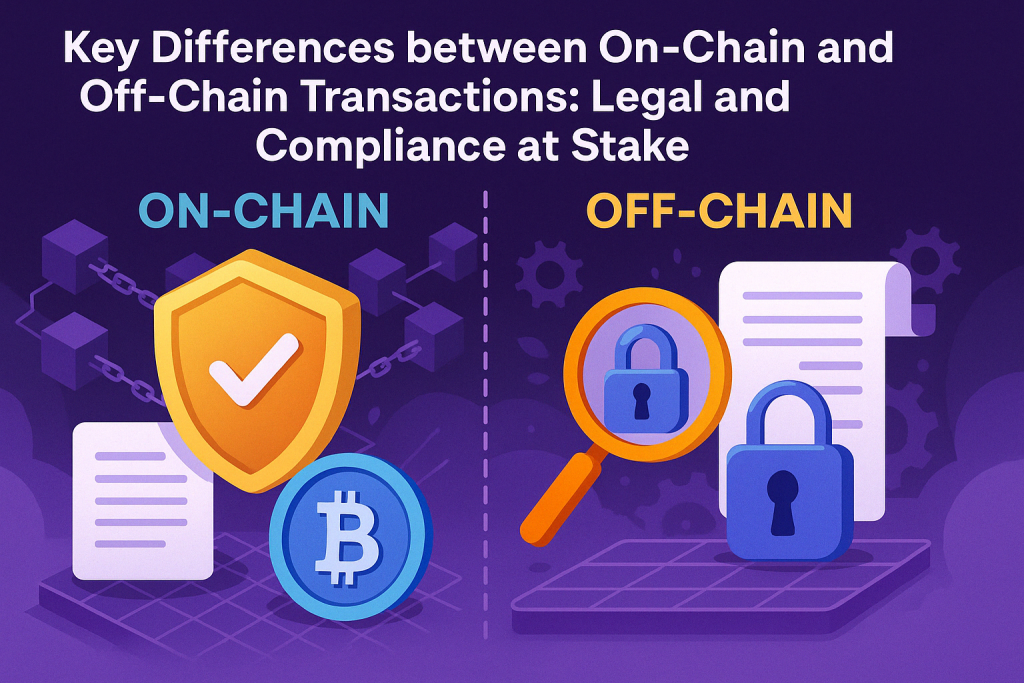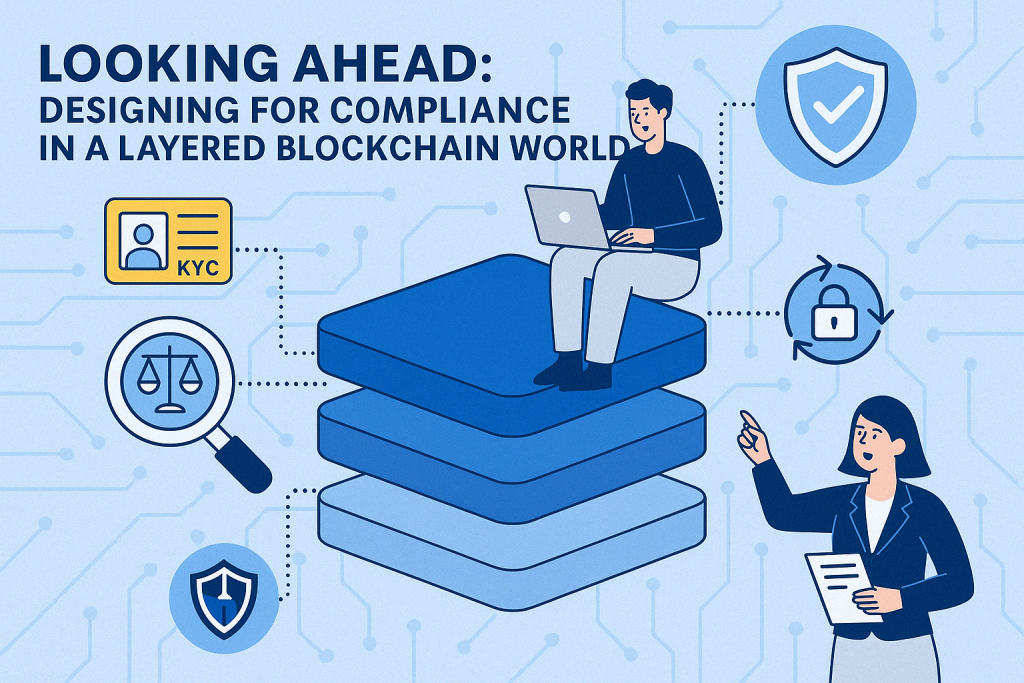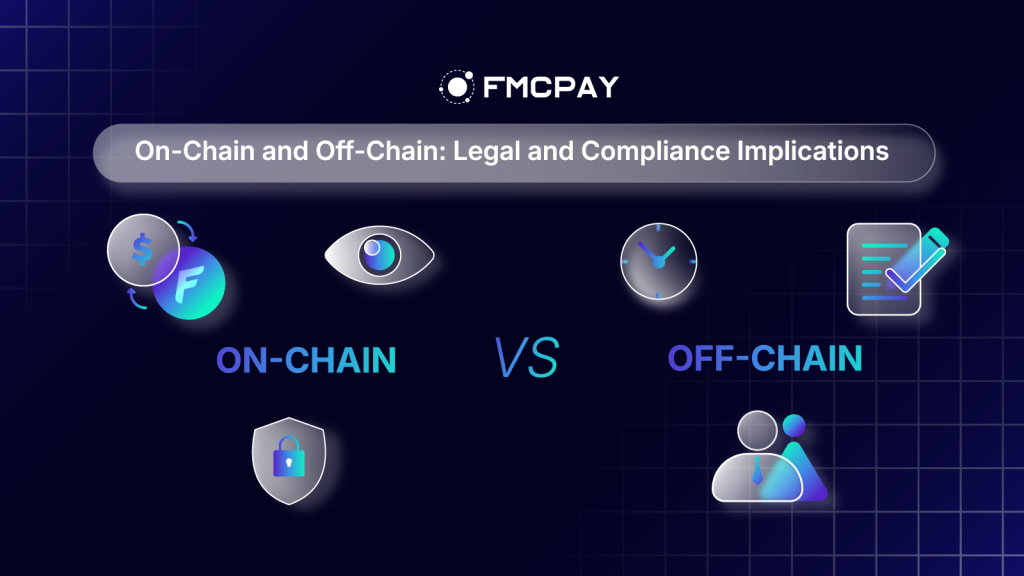On-Chain and Off-Chain transactions are fundamental components of how blockchain systems operate and as blockchain technology continues to evolve, understanding the distinctions between the two becomes increasingly crucial, especially from a legal and compliance standpoint. Each transaction type presents unique advantages and challenges that can significantly impact regulatory adherence, data privacy, and operational efficiency.
1. Understanding On-Chain and Off-Chain Transactions
In blockchain ecosystems, not all transactions are created equal. They are broadly classified into on-chain and off-chain activities each with distinct legal, technical, and compliance implications.
- On-Chain Transactions: Are those recorded directly on a blockchain network like Ethereum or Bitcoin. They are transparent, immutable, and verifiable by the public. Once submitted, they become part of a permanent, distributed ledger.
- Off-Chain Transactions: On the other hand, happen outside the blockchain. They may occur between two users directly (peer-to-peer), within a centralized database (e.g. on a crypto exchange), or through Layer 2 solutions like State Channels or Rollups. These are often faster and cheaper, but rely more on trust and external verification.
2. Key Differences between On-Chain and Off-Chain transactions: Legal and Compliance at Stake
Understanding the differences between On-Chain and Off-Chain transactions is essential for navigating the regulatory landscape of blockchain systems. Each model offers unique benefits and introduces specific challenges when it comes to transparency, trust, cost, and legal accountability.

2.1. Transparency
- On-Chain Transactions:
One of the core strengths of On-Chain transactions is their built-in transparency. Every transaction is permanently recorded on a public blockchain ledger and can be independently verified by regulators, auditors, and third parties. This level of visibility supports compliance efforts such as anti-money laundering (AML), real-time monitoring, and financial auditing. However, while On-Chain and Off-Chain systems both deal with sensitive data, the fully public nature of On-Chain transactions means that pseudonymous activity can sometimes be linked to real-world identities, raising potential privacy concerns. - Off-Chain Transactions:
In contrast, Off-Chain transactions are processed outside the public blockchain, often within centralized databases or Layer 2 protocols. While Off-Chain activity boosts performance and speed, it sacrifices transparency, making regulatory supervision more difficult. Verifiability in Off-Chain systems relies heavily on internal logs or third-party attestations, which may complicate audits, especially in high-frequency or cross-border applications.
2.2. Immutability
- On-Chain Transactions:
On-Chain transactions are immutable by design. Once a transaction is validated and included in a block, it becomes a permanent and tamper-proof part of blockchain history. This immutability is critical for ensuring the legal integrity of records in areas such as smart contract enforcement, financial settlements, and decentralized governance. In compliance-driven sectors, the reliability of On-Chain data offers significant legal advantages. - Off-Chain Transactions:
In Off-Chain systems, transactions are typically stored in private or semi-private environments where changes can be made more easily. As a result, Off-Chain transactions lack the strong guarantees of permanence found in On-Chain systems. This introduces legal risk in case of disputes, as proving the integrity of an Off-Chain transaction may require additional documentation, internal logs, or third-party verification.
2.3. Speed and Cost
- On-Chain Transactions:
While on-chain transactions prioritize security and decentralization, they often suffer from slower speeds and higher costs. Every on-chain transaction must be validated by the network, which incurs gas fees and can take several seconds or even minutes depending on network congestion. This makes on-chain activity less suitable for high-frequency use cases like gaming or real-time payments. - Off-Chain Transactions:
Off-chain transactions provide a scalable alternative by minimizing or eliminating the need for network validation at every step. These transactions can be processed in milliseconds and usually come with little to no transaction fee, especially in systems like centralized exchanges or payment channels. As a result, off-chain transactions are widely adopted for applications where speed and affordability are paramount.
2.4. Trust Model
- On-Chain Transactions:
On-chain transactions operate in a trustless environment. They rely on decentralized consensus algorithms (such as Proof of Work or Proof of Stake) to validate and secure transactions without needing a central authority. This reduces the risk of fraud or manipulation and supports the creation of open, permissionless systems where participants do not need to know or trust one another. - Off-Chain Transactions:
Off-chain transactions, by design, require users to trust a third-party intermediary or a pre-defined protocol to accurately record and process transactions. Whether it’s a centralized crypto exchange or a payment settlement layer, the reliability of off-chain systems hinges on the operational integrity and transparency of the party managing the transaction environment.
2.5. Regulatory Exposure
- On-Chain Transactions:
Because on-chain transactions leave a publicly verifiable trail, they are generally easier for regulators and compliance officers to audit. This can be advantageous in sectors like finance, supply chain, and digital identity, where verifiable records are crucial. However, this same transparency can pose challenges in regions with strict data privacy laws, such as the GDPR in Europe. Storing personally identifiable information (PII) directly on-chain may conflict with the “right to be forgotten” and data minimization principles. - Off-Chain Transactions:
Off-chain transactions offer more flexibility in data handling and can be structured to meet privacy requirements more easily. Sensitive information can be stored in controlled environments with access restrictions, making it easier to implement data protection and compliance frameworks. However, the lack of inherent auditability means that off-chain systems must implement robust logging and reporting mechanisms to satisfy regulators and ensure trust.
3. Real-World Examples of On-Chain and Off-Chain Transactions
Understanding how on-chain and off-chain transactions work in real-world scenarios helps clarify their respective advantages, trade-offs, and legal considerations. Below are practical examples that illustrate how each model functions in different blockchain applications.
3.1. On-Chain Transactions
In a typical example of an on-chain transaction, a user transfers ETH from their wallet to another address on the Ethereum blockchain. This transaction is recorded directly on the blockchain, confirmed by the network, and made publicly visible through block explorers like Etherscan. Because it is permanently stored on-chain, it provides a transparent and immutable audit trail. Such on-chain transactions are widely used in decentralized finance (DeFi), where trustless verification and regulatory traceability are essential.
Other common on-chain examples include NFT minting, DAO voting, or interacting with smart contracts on DEXs like Uniswap each transaction is executed and stored on the public ledger, reinforcing the principles of decentralization and verifiability.
3.2. Off-Chain Transactions
Off-chain transactions take place outside of the blockchain and are often used when speed, cost-efficiency, or privacy is prioritized. A clear example of an off-chain transaction is when a user exchanges BTC for USDT on a centralized exchange like Binance. While the trade is reflected instantly in the exchange’s internal system, it is not published to the blockchain unless the user initiates a withdrawal. Until that point, the transaction remains off-chain and outside the public ledger.
Other instances of off-chain transactions include microtransactions in gaming platforms, custodial wallet transfers, or payment activity within Layer 2 networks like State Channels where transaction finality is deferred until a batch settlement is pushed to the base layer.
3.3. Hybrid Use Cases Combining On-Chain and Off-Chain
Many blockchain-based applications now adopt hybrid models that strategically integrate both on-chain and off-chain transactions. For example, a Web3 gaming platform may process in-game actions and rewards off-chain to ensure real-time responsiveness and low latency. However, when a user earns a significant milestone or a rare collectible, the system may mint it as an NFT on-chain preserving digital ownership on a verifiable, tamper-proof ledger.
Another powerful hybrid example is zk-Rollups, where hundreds of off-chain transactions are bundled together, and a single cryptographic proof is published on-chain. This allows applications to scale efficiently while still inheriting the security and regulatory auditability of on-chain infrastructure.
4. Legal and Compliance Implications of On-Chain and Off-Chain Activity
As blockchain adoption spreads across industries, the legal and regulatory considerations surrounding on-chain and off-chain transactions have become increasingly significant. Each model introduces unique challenges in data governance, jurisdiction, and auditability that directly affect how organizations design their compliance strategies.

4.1. Transparency vs. Privacy
On-chain activity offers inherent transparency, making it highly suitable for regulatory oversight, financial auditing, and anti-money laundering (AML) compliance. Every on-chain transaction is publicly recorded on a distributed ledger, enabling real-time traceability. However, this same transparency can pose serious privacy risks. For example, if a wallet address is linked to personally identifiable information (PII), that user’s financial activity may become permanently exposed potentially conflicting with data privacy regulations such as the EU’s General Data Protection Regulation (GDPR).
In contrast, off-chain transactions allow for greater control over personal data. Organizations can decide where and how data is stored, implement encryption protocols, and design access permissions. This makes off-chain systems appealing for applications involving sensitive user information or compliance with stringent privacy laws. However, the reduced traceability of off-chain activity can present challenges in fraud detection, dispute resolution, and regulatory audits.
4.2. Jurisdiction and Legal Accountability
The decentralized nature of on-chain systems often complicates legal jurisdiction. Because on-chain and off-chain transactions can occur across borders without intermediaries or centralized control, it’s not always clear which legal framework applies in the case of a dispute. A smart contract deployed on Ethereum, for example, may involve users in multiple countries with varying laws on financial activity, consumer protection, and digital identity.
On the other hand, off-chain transactions conducted through centralized entities such as exchanges, custodial wallets, or Layer 2 platforms typically fall under the legal jurisdiction of the organization’s headquarters. These entities provide defined points of legal accountability, making it easier for governments and regulators to apply existing financial, tax, and consumer protection laws. As a result, off-chain systems are often more readily embraced by traditional financial institutions seeking regulatory clarity.
4.3. Recordkeeping and Auditability
In terms of audit-readiness, on-chain transactions provide an advantage through immutable, timestamped records. All activity is preserved on the blockchain and can be independently verified by regulators, auditors, or third-party tools. This level of verifiability makes on-chain systems particularly effective in compliance-heavy sectors such as finance, healthcare, and supply chain management.
However, off-chain activity requires proactive recordkeeping measures to meet regulatory expectations. Because off-chain transactions are not automatically recorded on a public ledger, organizations must implement internal logging systems, maintain audit trails, and periodically submit reports to compliance bodies. Ensuring the integrity of off-chain data from trade records to user actions demands both technical safeguards and procedural oversight, including third-party audits and attestations.
5. Things to Keep in Mind When Using On-Chain and Off-Chain Systems
Choosing between on-chain and off-chain systems depends on the type of transaction, regulatory environment, and operational priorities. Below are key scenarios with recommended approaches and legal considerations.

5.1. High-Value, Long-Term Asset Storage
When it comes to storing digital assets of significant value such as NFTs, tokenized real estate, intellectual property, or long-term financial instruments—the choice between on-chain and off-chain transactions has critical implications for security and compliance. In these cases, on-chain transactions are typically the preferred solution due to their immutability, transparency, and decentralized verification.
By recording asset ownership directly on-chain, organizations and individuals benefit from a permanent, tamper-proof, and publicly verifiable ledger. This is especially valuable in legal scenarios such as inheritance claims, tax reporting, and intellectual property disputes, where the ability to independently prove ownership is essential. The immutable nature of on-chain systems ensures that once recorded, asset details cannot be altered eliminating ambiguity and enhancing legal defensibility.
While off-chain systems may offer faster processing or more flexible data management, they lack the long-term auditability and trust guarantees required for high-value assets. For this reason, storing critical records via on-chain transactions, with optional off-chain data references for supplementary information, provides the most secure and compliant framework for long-term digital asset custody.
5.2. Frequent Microtransactions (e.g. Gaming, Rewards Systems)
In use cases that involve high-frequency, low-value exchanges such as in-game purchases, loyalty rewards, or pay-per-click advertising choosing the right balance between on-chain and off-chain transactions is essential. Relying solely on on-chain transactions in these scenarios can be inefficient due to high gas fees, slower confirmation times, and network congestion, especially on busy Layer 1 blockchains like Ethereum.
This is where off-chain transactions and Layer 2 scaling solutions (such as payment channels, optimistic rollups, or state channels) offer a significant performance advantage. By executing activity off-chain, platforms can dramatically reduce costs and achieve near-instant transaction finality, improving the user experience and platform scalability.
However, the nature of off-chain systems means that transactions do not immediately appear on a public blockchain ledger. To maintain trust and accountability, it’s critical to implement fallback mechanisms such as dispute resolution protocols or the option to escalate and finalize on-chain. These hybrid setups ensure that users benefit from the efficiency of off-chain transactions while preserving the integrity and verifiability that on-chain settlement provides when needed.
5.3. Sensitive Data Transfer
When handling personally identifiable information (PII) or regulated user data, choosing between on-chain and off-chain transactions has significant compliance implications. Storing sensitive information directly through on-chain transactions can create legal risks especially under regulations like the General Data Protection Regulation (GDPR), which grants users the right to erase or modify personal data. Since data recorded on-chain is immutable, it cannot be altered or deleted, making full compliance difficult or even impossible in some jurisdictions.
To address these challenges, organizations should consider off-chain systems for managing sensitive information. Off-chain transactions allow data to be stored in controlled environments, where encryption, access controls, and data retention policies can be applied in line with privacy regulations. Additionally, integrating privacy-preserving technologies such as zero-knowledge proofs (zk-proofs) can provide a way to verify certain facts on-chain without revealing the underlying data. This approach enables blockchain systems to maintain both compliance and credibility, effectively balancing the transparency of on-chain mechanisms with the privacy benefits of off-chain infrastructure.
5.4. Regulated Financial Activity
In highly regulated sectors like banking, securities, or cross-border payments, a hybrid model that integrates on-chain and off-chain components is often ideal. For example, real-time transaction processing and user identity verification can occur off-chain, while final settlements and proofs are recorded on-chain. This approach ensures both compliance and efficiency. Leveraging rollups or enterprise-grade Layer 2 solutions allows institutions to implement KYC/AML checks without compromising decentralization or legal auditability.
6. Looking Ahead: Designing for Compliance in a Layered Blockchain World
As blockchain networks evolve and diversify particularly with the rapid growth of Layer 2 Scaling Solutions the lines between on-chain and off-chain transactions are becoming increasingly blurred. In this layered blockchain architecture, many applications now combine both models: executing operations off-chain to reduce costs and improve speed, while anchoring final proofs or settlements on-chain to ensure integrity and verifiability.

This hybrid reality calls for a new approach to regulation. Compliance frameworks must evolve to accommodate the nuances of on-chain and off-chain systems, balancing transparency, data privacy, and operational efficiency. Traditional “one-chain-fits-all” rules no longer apply.
Leading blockchain projects are already paving the way by embedding compliance into core infrastructure:
-
Smart contracts are being upgraded to include KYC/AML modules, enabling automated verification while preserving the decentralized ethos of on-chain protocols.
-
Zero-knowledge proofs are increasingly used to validate off-chain activities without exposing sensitive data then submit cryptographic proofs on-chain, achieving both privacy and auditability.
-
Granular access controls are being developed to allow regulators to verify activity selectively within on-chain and off-chain networks, without compromising full-system decentralization.
Platforms like FMCPAY are at the forefront of this evolution. By integrating secure off-chain processing for faster, user-friendly experiences, while ensuring on-chain verifiability and compliance hooks, FMCPAY is helping bridge the gap between scalability and regulation. The platform’s commitment to security, transparency, and future-ready infrastructure positions it as a key player in the next generation of compliant blockchain ecosystems.
As the industry moves forward, the ability to design legally resilient, hybrid infrastructure will be crucial. Those who master the balance between on-chain integrity and off-chain efficiency will define the future of Web3 adoption at scale.
7. Final Thoughts
The decision between on-chain and off-chain solutions is more than a technical choice it’s a matter of compliance and long-term viability. As blockchain adoption accelerates, understanding the legal risks, transparency trade-offs, and use-case fit of on-chain and off-chain transactions becomes essential.
While on-chain systems offer security and verifiability, they may raise privacy concerns. Meanwhile, off-chain models deliver speed and flexibility but require strong audit mechanisms to remain compliant. The most future-ready blockchain systems will combine both leveraging on-chain integrity with off-chain efficiency to meet global regulatory standards.
In the end, success in Web3 will come to those who build with both innovation and legal resilience in mind. For more insights on Web3 compliance, Layer 2 innovations, and blockchain use cases, visit FMCPAY News and stay ahead in the evolving digital economy.


